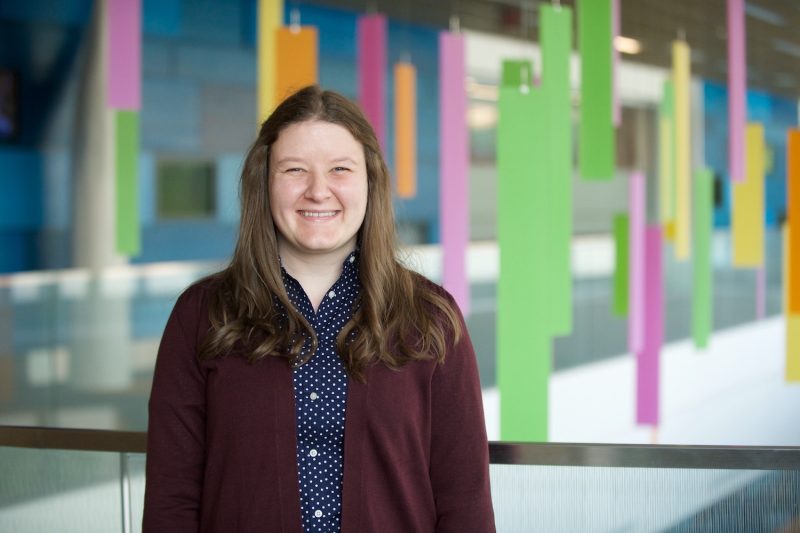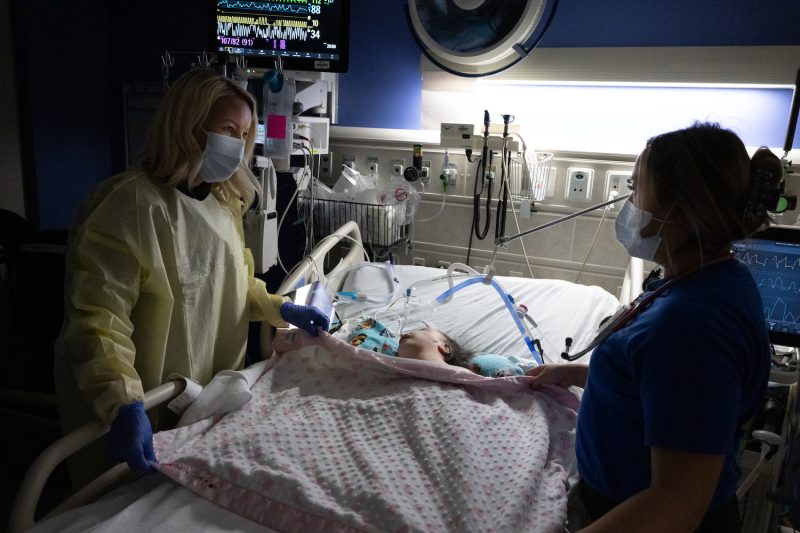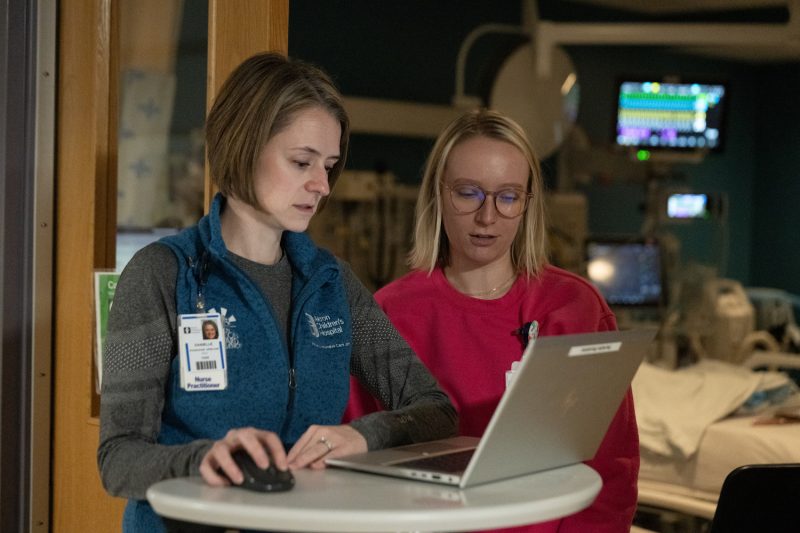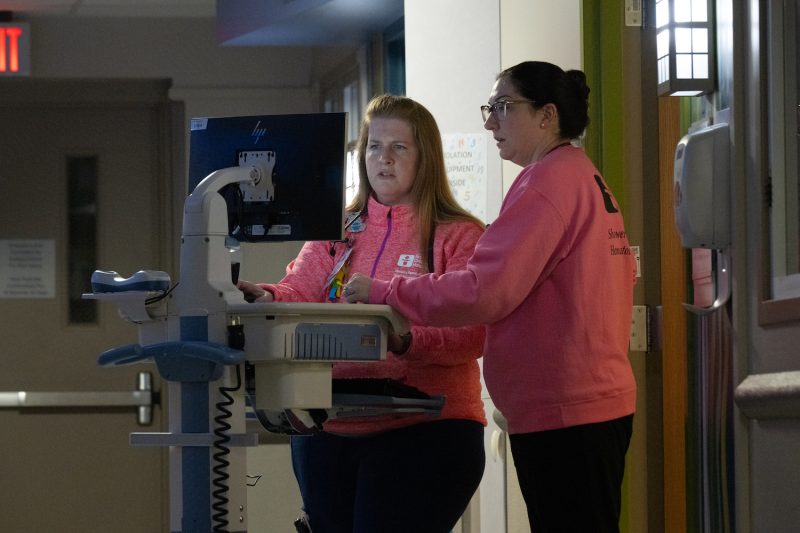
Physician assistant Staci Shaffer is Akron Children’s first APP night house officer.
Physician assistant Staci Shaffer has always been a bit of a “night owl,” so it’s no surprise that she is Akron Children’s first advanced practice provider (APP) night house officer, hired in 2017 when this service was added.
“I am happiest at 2 a.m.,” she said.
Staci loves the variety that this role offers, as our APP night house officers provide overnight coverage, from 6 p.m.-6 a.m., in the Burn Institute, trauma service, pediatric surgery, and ear, nose and throat.
“My role is part emergency/urgent care and part inpatient follow-up and post-op checks,” she said. “There is something different every night, so I’m never bored. I never know what cases are going to come in overnight.”
The APP night house officers may be called to assess and triage a burn injury in the outpatient clinic or provide care to inpatients with burn injuries. They may consult on a trauma case in the emergency department or be part of a trauma team activation. They also provide follow-up care to patients who are admitted after pediatric general surgery, as well as those who experience bleeding after a tonsillectomy and adenoidectomy, or who are admitted with an ENT concern. They see new consults in the emergency department for pediatric surgery as well.
Whatever comes her way, Staci won’t leave at the end of her shift until her last patient’s needs are met. A typical schedule is three months overnight and one month on days, so our APP night house officers can participate in further educational opportunities.
“It’s challenging to find opportunities for education, as most of that happens on the day shift, which is why we rotate to day shift when we are fully staffed. Overall, I love all of the various services I cover and I love working nights,” she said.
“My most memorable moment was when the night shift burn nurses said I had an outpatient burn to see and instead surprised me with a baby shower for my first child. I also enjoy celebrating the holidays overnight in the hospital such as Halloween, Christmas Eve and New Year’s Eve. The staff always make these nights an enjoyable experience when I am unable to be home with my family.”

As a lead APP in the Pediatric Intensive Care Unit, Kerrie Clark (left) manages patient care and serves as the first point of contact for nurses such as Aliyah Torgler (right).
Spirit of camaraderie, teamwork define the PICU
Kerri Clark and Danielle Standohar are two of the pediatric nurse practitioners who work in the Pediatric Intensive Care Unit (PICU) overnight. For every shift in the PICU, there are two nurse practitioners, each managing care for half of the unit and serving as the first point of contact for nurses. They handle admissions, examine patients, perform procedures and ensure the plan of care is implemented. They also provide education to Akron Children’s residents and other residents who rotate through the unit.
Danielle has worked at Akron Children’s for 15 years, always on nights.
“I was never a night owl, but while in nursing school, I did an overnight shift for six months and loved it,” she said. “There’s no script for the night shift. We’re taking care of problems or issues as they arise. While there may not be as many resources available in the hospital overnight, we get what we need and are good at responding quickly. Without as many helping hands, we are able to learn so much more.”
Kerri has worked at Akron Children’s for 20 years, with 10 years on the night shift. She enjoys bridging the gap between the attending physicians and nurses.
“As lead APP, I have administrative functions that I perform during the day, so at night my focus is patient care. I like having a clean break between these two roles, which being on nights allows,” Kerri said.

Pediatric nurse practitioner Danielle Standohar (left) has always worked the night shift, bridging the gap between the attending physicians and nurses in the PICU, such as Shelby Skero (right).
For Danielle, the most memorable moments on the night shift are those serious emergency situations when a child is admitted from the emergency department or needs ECMO.
“During those high-stress moments when everyone comes together, our unit really shines,” she said.
Kerri agreed, noting that with less staff here at night, the entire unit and often others from throughout the hospital, pull together as one cohesive team.
“Everyone is in the room for a serious case and we’re able to do what the patient needs.”
For Kerri, another memorable moment is a pilot she is working on with Danielle Paulin, DO, a pediatric emergency medicine physician and director of pediatric emergency ultrasound; Jean Christopher, a clinical nurse specialist in the PICU, and Melanie Brewster, a critical care registered nurse who is working to become a clinical nurse specialist in the PICU.
“At night, there is no vascular access team, so we are piloting ultrasound-guided peripheral IV placement in the PICU,” Kerri said. “I’ve enjoyed helping nurses learn a new skill and expand their scope of practice. This evidence-based project is exciting and builds camaraderie between the nurses and nurse practitioners.”
For Danielle, another benefit of the night shift is the work-life balance it allows.
“There’s a misperception that we don’t get to see our families. The reality is I get to see them more,” she said. “I have dinner with my kids and I’m home when they get up in the morning.”

Pediatric nurse practitioners Annie Smith and Lauren Niehaus who work the night shift on the hematology-oncology unit develop close relationships with their patient families and know they are making on impact.
Hematology-oncology APPs relish special moments with patients
Annie Smith, a pediatric nurse practitioner on the hematology-oncology inpatient unit, also appreciates the work-life balance of working the night shift. She has three young children at home. Annie joined Akron Children’s a little over a year ago and is fulfilling a dream to work as a nurse practitioner in hematology-oncology.
“I was a music therapist on a hematology-oncology floor in Dallas. After I became a nurse, I returned to Ohio, where I began my nurse practitioner career in a MinuteClinic. I was thrilled when I had the opportunity to come to Akron Children’s in this role,” she said. “No one day is the same. I found the MinuteClinic to be boring, but here I am learning and growing. It’s stressful, but it’s rewarding to use my skills and my brain.”
Lauren Niehaus, who also works as a pediatric nurse practitioner in hematology-oncology, was a night-shift nurse at Akron Children’s for eight years. She left to become a traveling nurse, then worked in a medical spa. She returned about a year ago as a nurse practitioner after having a baby.
“I like that this role is a step further than the usual bedside nurse. It’s why I went back to school. I’m still at the bedside, but I’m expanding my critical thinking skills. It’s a nice balance,” she said.
“While we are more independent on the night shift, we still collaborate with the doctors, as well as with other departments and specialists. You learn where your resources are,” Annie said.
“We also like to bounce ideas off each other,” said Lauren. “Very rarely is there just one nurse practitioner on the shift. There are usually two.”
The hematology-oncology floor has a pager, so the nurse practitioners field calls at any time of the night from patient families who have concerns, such as if their child has a fever. Certain cancers are more high risk for infection.
“During the day, patients with fever go to the clinic, but at night, we have them come straight to the unit instead of the emergency department where there is greater risk for exposure,” Annie said.
Answering calls from patient families is another opportunity to use their critical thinking skills, as they try to determine what is going on with the patient.
Lauren recalled a memorable night when they received a call that a liver was available for a patient who had been on a wait list for a transplant. The family had transportation issues, so she arranged for an Uber to get the family to Cincinnati as quickly as possible.
“We become part of the patients’ families,” said Annie. “We had a really sick child who was about 2 years old. Her parents were not here a lot, so we would spend as much time as we could with her. She was so happy to be out of her room and to be held.”
Lauren reiterated that through these relationships, they know they are making an impact.
“I love working Christmas Eve because we get to be Santa and deliver presents. There’s also a lower census during the holidays, so we get to spend more time with our patient families,” she said.










